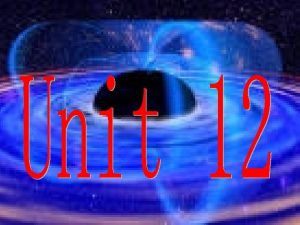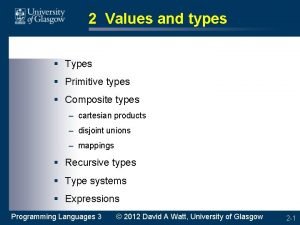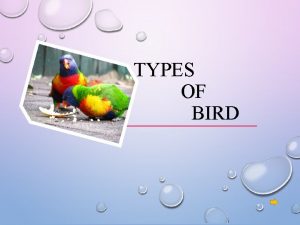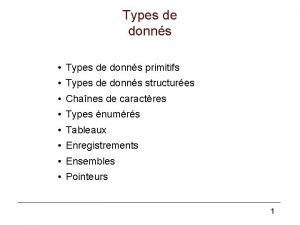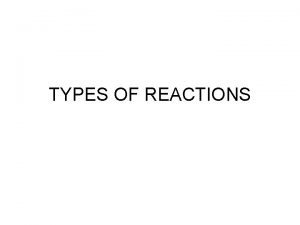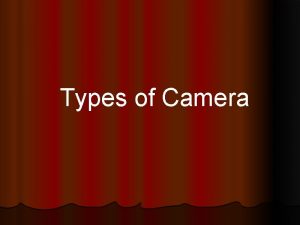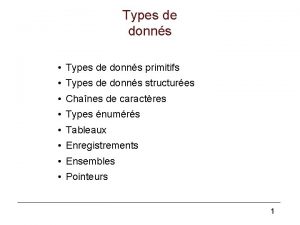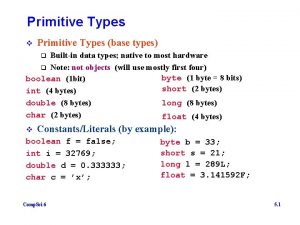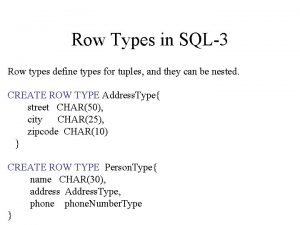Monday 4 18 and Tues 4 19 Types

















- Slides: 17

Monday 4 -18 and Tues 4 -19 Types of Solutions and Solubility Curves Mrs. Wilson

Objectives • Distinguish between solutions, colloids, and suspensions; electrolytes and non-electrolytes; and strong / weak electrolytes. • Distinguish between solutions based on their degree of saturation: saturated, supersaturated, and unsaturated solutions. • Interpret solubility curves for different ionic compounds to determine the degree of saturation of a solution. Homework: Colors of Chemistry Lab due next class. We’ll finish the lab questions next class.

Daily Quiz • You do not need a calculator. You do need a periodic table.

Lesson 6. 5: Types of Solutions A. Solutions, Colloids, Suspensions

Lesson 6. 5: Types of Solutions A. Solutions, Colloids, Suspensions Solution Colloid Tyndall effect: shown only in colloids – the colloidal particles are larger than the wavelength of the incident light, so that light beam “scatters” or broadens in width. Think of car headlights shining through fog.

Lesson 6. 5: Types of Solutions B. Electrolytes vs. Nonelectrolytes; Weak vs. Strong Electrolytes Dissociation = separation of ions from each other All three solutions have complete dissolution (solute is completely dissolved) 0% dissociation Ex: Sugar water ~100% dissociation Ex: Vinegar, ammonia Ex: HCl, salt water

DEMO and VIDEO • Water, Gatorade, Monster • Any of you have drinks you want to test? (You can’t drink them afterwards, obviously…)

Lesson 6. 5: Types of Solutions C. Saturated, Unsaturated and Supersaturated Solutions Unsaturated = contains less than the max. mass of solute that could possibly dissolve in 100 g of H 2 O at a given temperature. Saturated = contains the max. mass of solute that can dissolve in 100 g H 2 O at a given temp. ** The only factor that can change the solubility of a solute is temperature and pressure (for gaseous solutes only). To make a saturated solution, unsaturated, heat the solution! **As long as that temp. remains constant, any extra solid solute will be undissolved at the bottom of the saturated solution.

VIDEO • Unsaturated, Saturated and Supersaturated Project

Supersaturated = contains more than Lesson 6. 5: Types of Solutions C. Saturated, Unsaturated and Supersaturated Solutions the max. mass of solute that solution can normally dissolve • Make a saturated solution (w/ undissolved solute at the bottom) • Heat the mixture to dissolve the solute (now it’s unsaturated) • Cool the mixture EXTREMELY SLOWLY. Now it’s supersaturated. Ø This system is unstable – any disturbance or the addition of a “seed crystal” will trigger crystallization to re-form a saturated solution.

QUICK LAB and VIDEO • Crystallization • There are three setups. • Perform a test to see if the two test tubes contain an unsaturated, saturated or supersaturated solution. • Obtain a test tube that contains a warmed solution. Perform a test to see if this test tube contains an unsaturated, saturated or supersaturated solution. Return this test tube to the hot water bath.

Lesson 6. 5: Types of Solutions C. Saturated, Unsaturated and Supersaturated Solutions Another way to distinguish degrees of saturation is to consult a solubility curve. Supersaturated Unsaturated

• Any point on a line represents a saturated solution. Example • At 90 o. C, 40 g of Na. Cl(s) in 100 g H 2 O(l) represent a saturated solution. • Any point below a line represents an unsaturated solution. Example • At 90 o. C, 30 g of Na. Cl(s) in 100 g H 2 O(l) represent an unsaturated solution. 10 g of Na. Cl(s) has to be added to make the solution saturated.

• Any point above a line represents a supersaturated solution. Example • At 90 o. C, 50 g of Na. Cl(s) in 100 g H 2 O(l) represent a supersaturated solution. Eventually, 10 g of Na. Cl(s) will crystallize; the liquid above the crystals will be saturated. Any solution can be made saturated, unsaturated, or supersaturated by changing the temperature. • For solid solutes, when T increases, solubility increases. • For gaseous solutes, when T decreases, solubility increases.


(answers to these questions and the homework is online)

Let’s go over the test…
 Mon tues wed thurs fri
Mon tues wed thurs fri On monday i (have) math and art
On monday i (have) math and art Monday dua and ziyarat
Monday dua and ziyarat On monday and tuesday
On monday and tuesday Mon-tues-wed-thurs-fri-sat-sun
Mon-tues-wed-thurs-fri-sat-sun Mon tue wed thurs fri sat sun
Mon tue wed thurs fri sat sun Sun mon tue
Sun mon tue Wed thurs fri
Wed thurs fri Mon tues wed
Mon tues wed Mon tue wed thur fri sat sun
Mon tue wed thur fri sat sun Mon tues wed thurs fri sat sun
Mon tues wed thurs fri sat sun Montues
Montues Sun mon tue wed thu fri
Sun mon tue wed thu fri Sun thu
Sun thu Mon tue wed
Mon tue wed Mon tue
Mon tue Mon tue
Mon tue Sun mon tues
Sun mon tues

